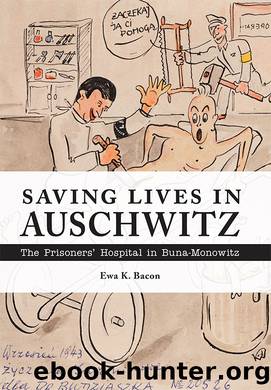Saving Lives in Auschwitz by Ewa K. Bacon

Author:Ewa K. Bacon [Bacon, Ewa K.]
Language: eng
Format: epub
Tags: History, Holocaust
ISBN: 9781612494937
Google: _gmyDwAAQBAJ
Publisher: Purdue University Press
Published: 2017-06-15T22:15:58+00:00
Stefan next turns to the topic of music-making in the camp. But why would he segue to this unlikely topic? He is likely struggling with the memory of his most difficult task: prisoner physicians had to obey selection orders. So, he digresses. He describes activities he promoted to ameliorate the tensions and tedium of hospitalization. He organized musical events. The first camp orchestra, manned by prisoners, was organized in the main Auschwitz camp and was performing by January, 1941. Its function was entirely practical: the music helped maintain the cadence of the men marching in and out of camp. Both formal and informal concerts followed, and camp orchestras organized in the other camps. Langbein writes movingly about the comfort prisoners and prisoner performers derived from music-making.33 Makowski remembers these concerts as well and stated that some lasted for hours and were a welcome event.34 The patients in Buna-Monowitz heard concerts every other Saturday.35
To relieve the monotony, I organized performances of the camp orchestra for the sick prisoners. They took place in an internal courtyard, which was created when we built connections between the barracks. The performers were soloists such as Stasiak, Wojszczyk, and others. This project was made easier since I was acquainted with many of the prisoners who cooperated with my requests. This type of concert by the camp orchestra was also put on for the other prisoners at Monowitz; they even organized a kind of review. Famous singers appeared at these concerts, including a tenor with a booming voice. He had been brought to KL Auschwitz from the Compiegne camp and was then poisoned in the camp hospital by that prisoner group from Buchenwald I mentioned earlier. That prisoner had been accused of treason or denunciation. That all took place in 1944, I donât remember the exact date or the prisonerâs nameâhe spoke Polish and was under Heymannâs direction. I learned about this after the fact.
There is no other reference to the mysterious tenor with the booming voice. Stefan attributes this murder to the Buchenwald contingent. The relationships between Stefan and many of his coworkers and the cohort of older, ideologically opposed prisoners continued to be tense with mutual suspicion. Stefanâs narrative returns again to the fraught issue of prisoner death rate and adds more details.
I cannot recall ever getting any orders limiting the time a prisoner could spend in the hospital. On the other hand, the number of patients was not allowed to be more than 10% of the inmates of KL Auschwitz III. At the same time, the number of sick was markedly larger than the capacity of the hospital barracks. To somehow deal with the disparity I organized so-called ârecoveryâ wards (Schonungsblock) to which less severe cases were moved and protected from selections. A lot depended on the psychological resistance of the sick. I remember, for instance, the tragedy of the Dutch Jews. Before their arrests and deportations they lived in optimal conditions. When they came to the concentration camp they werenât able to or couldnât come to terms with the grim conditions and regimes.
Download
This site does not store any files on its server. We only index and link to content provided by other sites. Please contact the content providers to delete copyright contents if any and email us, we'll remove relevant links or contents immediately.
| Administration & Medicine Economics | Allied Health Professions |
| Basic Sciences | Dentistry |
| History | Medical Informatics |
| Medicine | Nursing |
| Pharmacology | Psychology |
| Research | Veterinary Medicine |
The Immortal Life of Henrietta Lacks by Rebecca Skloot(4525)
An American Plague by Jim Murphy(3711)
The Emperor of All Maladies: A Biography of Cancer by Siddhartha Mukherjee(3066)
The Gene: An Intimate History by Siddhartha Mukherjee(3047)
The Fate of Rome: Climate, Disease, and the End of an Empire (The Princeton History of the Ancient World) by Kyle Harper(3003)
Rebecca Skloot by The Immortal Life of Henrietta Lacks(1978)
Stiff - The Curious Lives of Human Cadavers by Mary Roach(1814)
The Great Influenza by John M Barry(1750)
The Vaccine Race by Meredith Wadman(1629)
Undue Risk by Moreno Jonathan D.;(1600)
Hero by Michael Grant(1586)
Three Cups of Tea by Greg Mortenson(1576)
The Mystery of the Exploding Teeth by Thomas Morris(1540)
Quackery by Lydia Kang(1519)
Autism's False Prophets by Paul A. Offit(1496)
Extremes: Life, Death and the Limits of the Human Body by Fong Kevin(1484)
A Journal of the Plague Year (Oxford World's Classics) by Daniel Defoe(1481)
Steroids: History, Science, and Issues by Standora Joan E.; Bogomolnik Alex; Slugocki Malgorzata(1479)
The Vaccine Court by Rohde Wayne(1471)
